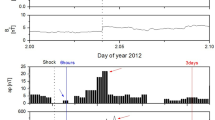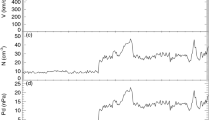Abstract
Interplanetary shock can greatly disturb the Earth’s magnetosphere and ionosphere, causing the temporal and spatial changes of the magnetic field and plasmas at the geosynchronous orbit. In this paper, we use the magnetic field data of GOES satellites from 1997 to 2007 and the plasma data of MPA on the LANL satellites from 1997 to 2004 to study the properties of magnetic field and plasma (0.03–45 keV) at the geosynchronous orbit (6.6 R E) within 3 hours before and after the arrival of shock front at the geosynchronous orbit through both case study and superposed epoch analysis. It is found that following the arrival of shock front at the geosynchronous orbit, the magnetic field magnitude, as well as GSM BZ component increases significantly on the dayside (8–16 LT), while the B Y component has almost no change before and after shock impacts. In response to the interplanetary shock, the proton becomes much denser with a peak number density of 1.2 cm−3, compared to the typical number density of 0.7 cm−3. The proton temperature increases sharply, predominantly on the dusk and night side. The electron, density increases dramatically on the night side with a peak number density of 2.0 cm−3. The inferred ionospheric O+ density after the interplanetary shock impact reaches the maximum value of 1.2 cm−3 on the dusk side and exhibits the clear dawn-dusk asymmetry. The peak of the anisotropy of proton’s temperature is located at the noon sector, and the anisotropy decreases towards the dawn and dusk side. The minimum of temperature anisotropy is on the night side. It is suggested that the electromagnetic ion cyclotron (EMIC) wave and whistler wave can be stimulated by the proton and electron temperature anisotropy respectively. The computed electromagnetic ion cyclotron wave (EMIC) intense on the day side (8–16 LT) with a frequency value of 0.8 Hz, and the wave intensity decreases towards the dawn and dusk side, the minimum value can be found on the night side. The computed electron whistler wave locates on the day side (8–16 LT) with a value of 2 kHz.
Similar content being viewed by others
References
Rufenach C L, McPherron R L, Schaper J. The quit geomagnetic field at geosynchronous orbit and its dependence on solar wind dynamic pressure. J Geophys Res, 1992, 97: 25–42
Wang C, Liu J B, Huang Z H, et al. Response of the magnetic field in the geosynchronous orbit to solar wind dynamic pressure pulses. J Geophys Res, 2007, 112, A12210, doi:10.1029/2007JA012664
Patel V L, Coleman P J. Sudden impulses in the magnetosphere observed at synchronous orbit. J Geophys Res 1970, 75: 7255–7260
Lee D Y, Lyons L R. Geosynchronous magnetic field response to solar wind dynamic pressure pulse. J Geophys Res, 2004, 109, A04201, doi: 10.1029/2003JA010076
Borodkova N L, Zastenker G N, Riazantseva M, et al. Large and sharp solar wind dynamic pressure variations as a source of geomagnetic field disturbances at the geosynchronous orbit. Planet Space Sci, 2005, 53: 25–32
Lee D Y, Lyons L R, Reeves G D. Comparison of geosynchronous energetic particle flux responses to solar wind dynamic pressure enhancements and substorms. J Geophys Res, 2005, 110, A09213, doi: 10.1029/2005JA011091
Villante U, Piersanti M. An analysis of sudden impulses at geosynchronous orbit. J Geophys Res, 2008, 113, A08213, doi:10.1029/ 2008JA013028
Wang C, Liu J B, Li H, et al. Geospace magnetic field responses to interplanetary shocks. J Geophys Res, 2009, 114, A05211, doi:10. 1029/2008JA013794
Borovsky E B, Thomsen M F, Elphic R C, et al. The transport of plasma sheet material from the distant tail to geosynchronous orbit. J Geophys Res, 1998, 103: 20297–20331
Elphic R C, Weiss L A, Thomsen M F, et al. Evolution of plasmaspheric ions at geosynchronous orbit during times of high geomagnetic activity. Geo Res Letters, 1996, 23: 2189–2192
Birn J, Thomsen M F, Borovsky J E, et al. Characteristic plasma properties during dispersionless substorm injections at geosynchronous orbit. J Geophys Res, 1997, 102: 2309–2324
Dandouras I, Henri R, Cao J B, et al. Magnetosphere response to the 2005 and 2006 extreme solar events as observed by the Cluster and Double Star spacecraft. Adv Space Res, 2008, 43: 618–623
Borovsky J E, Denton M H. Relativistic-electron dropouts and recovery: A superposed epoch study of the magnetosphere and the solar wind. J Geophys Res, 2009, 114, A02201, doi:10.1029/2008JA013128
Denton M H, Thomsen M F, Korth H, et al. Bulk plasma properties at geosynchronous orbit. J Geophys Res, 2005, 110, A07223, doi:10.1029/2004JA010861
Denton M H, Borovsky J E. Superposed epoch analysis of high-speed-stream effects at geosynchronous orbit: Hot plasma, cold plasma, and the solar wind. J Geophys Res, 2008, 113, A07216, doi:10.1029/2007JA012998
Kennel C F, Petschek H E. Limit on stably trapped particle fluxes. J Geophys Res, 1966, 71: 1–28
Horne R B, Thorne R M. On the preferred source location for the convective amplification of ion cyclotron waves, J Geophys Res, 1993, 98: 9233–9247
Cornwall J M, Coroniti F V, Thorne R M. Turbulent loss of ring current protons. J Geophys Res, 1970, 75: 4699–4709
Thorne R M, Horne R B. The contribution of ioncyclotron waves to electron heating and SAR-arc excitation near the storm-time plasmapause. Geophys Res Left, 1992, 19: 417–420
Cornwall J M, Coroniti F V, Thorne R M. Unified theory of SAR arc formation at the plasmapause. J Geophys Res, 1971, 76: 4428–4445
Bossen M, McPherron R L, Russel C T. A statistical study of Pc I magnetic pulsations at synchronous orbit. J Geophys Res, 1976, 81: 6083–6091
Xiao F L. Modelling energetic particles by a relativistic kappa loss cone distribution function in plasmas. Plasma Phys. Controlled Fusion, 2006, 48: 203–213
Xiao F L, Zhou Q H, He H Y, et al. Energetic electron distributions fitted with a relativistic kappa-type function at geosynchronous orbit. J Geophys Res, 2008, 113, A05203, doi:10.1029/2007JA012903
Xiao, F L, Zhou Q H, Zheng H N, et al. Whistler instability threshold condition of energetic electrons by kappa distribution in space plasmas. J Geophys Res, 2006, 111, A08208, doi: 10.1029/2006JA011612
Xiao F L, Zhou Q H, He H Y, et al. Instability of whistler-mode waves by a relativistic kappa-loss-cone distribution inspace plasmas. Plasma Phys Controlled Fusion, 2006, 48, 1437–1445
Xiao F L, Zhou Q H, He H Y, et al. Electromagnetic ion cyclotron waves instability threshold condition of suprathermal protons by kappa distribution. J Geophys Res, 2007, 112, A07219, doi: 10.1029/2006JA012050
Singer H J, Matheson L, Grubb R, et al. Monitoring space weather with the GOES magnetometers. SPIE Proc, 1996, 2812: 299–308
Bame S J, McComas D J, Thomsen M F, et al. Rev Sci Instrum, 1993, 64: 1026–1033
McComas D J, Bame S J, Barraclough B L, et al. Magnetospheric plasma analyzer: Initial three-spacecraft observations from geosynchronous orbit. J Geophys Res, 1993, 98(A8): 13453–13465
Thomsen M F, Noveroske E, Borovsky J E, et al. Calculation of moments from measurements by the Los Alamos magnetospheric plasma analyzer. LA Rep LA-13566-MS, Los Alamos Natl Lab, Los Alamos, N M, 1999
Ghielmetti A G, Johnson R G, Sharp R D, et al. The latitudinal, diurnal, and altitudinal distributions of upward flowing energetic ions of ionospheric origin. Geophys Res Lett, 1978, 5: 59–62
Sharp R D, Carr D L, Peterson W K, et al. Ion streams in the magnetotail. J Geophys Res, 1981, 86: 4639–4648
Zong Q G. Energetic Oxygen Ions in Geospace Observed by Geotail Spacecraft. PhD dissertation. Brunswick: The Technical University Carolo-Wilhelmina, 1998. 118–123
Treumann R A, Baumjohann W. Advanced Space Plasma Physics. London: Imperial college, 1997:108–111
Author information
Authors and Affiliations
Corresponding author
Additional information
Supported by the National Natural Science Foundation of China (Grant No. 40831061)
About this article
Cite this article
Yue, C., Zong, Q. & Wang, Y. Response of the magnetic field and plasmas at the geosynchronous orbit to interplanetary shock. Chin. Sci. Bull. 54, 4241–4252 (2009). https://doi.org/10.1007/s11434-009-0649-6
Received:
Accepted:
Published:
Issue Date:
DOI: https://doi.org/10.1007/s11434-009-0649-6




